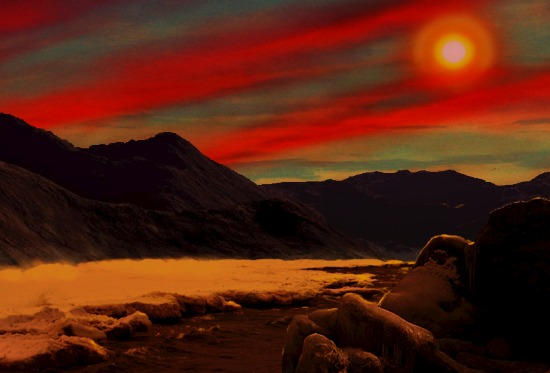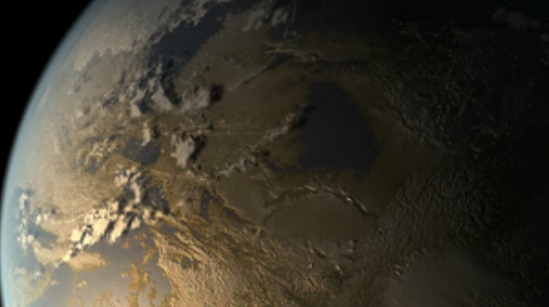
Kepler 186f, “Lycoris” by Karen Wehrstein. And she does this stuff at no charge, she depends solely on contribs. If anyone wants to drop a buck or two in her Paypal account at [email protected] that would be great.
We won’t know details of the surface of 186f for years, probably decades, at best. It could be a cool Venus, a warm Mars, or a water world with a thick, steamy atmosphere and no clear surface transition between vapor and liquid phases. It could have a highly reflective atmosphere or surface, locking it into a snowball state, colder than the North Pole and drier than the Atacama desert. It could be like nothing we have yet imagined. But we can have some fun guessing …
To start making a surface illustration, we went with this image, produced by NASA, featuring the consensus guess: a rocky terrestrial world, about 20 to 30 F degrees cooler than Earth, with a differentiated mantle, core, and crust giving rise to some level of moderate geo-thermal activity. See the large, roughly triangular lake just above center-right with the little tail heading out to the left? We wondered what it might look like there, down on the surface, looking ‘west’ toward the out-of-frame star.
We were unable to find any hard estimates of the system’s age. But Class M stars last a long time, so we assume at least a billion years or more, plenty of time for the world to slowly drift into tidal lock, like our moon, where one face is always lit and the other permanently in shadow. We assumed here that 186f is in the process of becoming locked. Its day is still shorter (Or possibly longer) than its year, keeping surface ice from accumulating on one side and driving a more active weather cycle. Another, mutually inclusive possibility: 186f has a swinging axis, it wobbles a lot.
For now there are no known planets further out than 186f, but they could be there, either orbiting too slowly for Kepler to have detected a transit or offset in orbits that don’t cross the star from our perspective. Regardless, the planet is much nearer the frost line than Earth is to its analogue — the distance from a sun where water and other common compounds can freeze and remain stable. The equivalent of our Kuiper Belt and our Oort Cloud might likewise lay relatively nearby and be teeming with icy objects. If so, it’s a near certainty that at least some water and other volatile substances would have been delivered to the planet over time, providing ice and oceans consistent with the NASA illustration. If the land under our ‘spot’ is a drab grayish color, it would probably look similar in color and a bit dimmer from the surface. If the oceans are pale blue on the day side, the sky would have to have some substantial blue portions, too. Thick air might add a subtle purplish tint to distant mountains.
Speaking of air and sky, in this alien orbit, about 33 million miles away as opposed to 93 million miles between the Earth and our sun, the star Kepler 186 would appear to be roughly the same size our sun appears to us, perhaps a tad smaller. Since the star produces some solar wind but little in the way of UV light, we thought here that the planet would retain a substantial atmosphere, even if its internal magnetic dynamo was dampened as the initial rotation began to merge with its annual trip around the star.
If this planet is ten percent larger than Earth in diameter and of the same average density, making it about one-third more voluminous, surface gravity would be about 1.05 – 1.15 g (I think anyway: gravity is non-linear and it depends a lot on how mass is distributed internally). Any lighter primeval helium or diatomic hydrogen accumulated early on in formation would easily escape, leaving behind heavier gasses. Pure speculation on surface pressure: with the cooler temperature and slightly higher gravity, we assumed about 29 pounds per square inch (200 Kilopascals), twice Earth normal, at whatever passes for sea level.
What gasses dominate can only be guessed at by looking at terrestrial worlds with an atmosphere in our solar system. The chief components are carbon dioxide (Venus and Mars) and nitrogen (Earth and Titan). We went with nitrogen as it is a stable gas throughout a range of temperatures, doesn’t produce an overpowering greenhouse effect like a thick blanket of CO2 would, and doesn’t require large amounts of oxygen to form in quantity. The lower average temperature we infer combined with a little less water than Earth has might mean water vapor and rain/sleet are less frequent or less heavy on our version of 186f than on Earth. Far less free oxygen with a subdued storm cycle and active geology and hydrology could mean only traces of CO2 and other oxides.
Partly for artistic effect, we surmised that that thick layer of air, combined with the redder light of Kepler 186 might make the star appear a bit larger and hazy as it hovers close to the horizon. The combination of redder light, scattering, and reflected light off an icy, frosty surface under-scores low, streaking methane rich clouds with a beautiful deep red hue. High altitude ice crystals and traces of water vapor add higher, white clouds and a hazy halo around the star embedded in a pale blue sky.
To sum it up, based partly on NASA’s consensus guess — with more than a few guesses of our own! — we made the region in question a mix of some alien and some familiar, more terrestrial features: frosty, rugged surface with a fairly subdued water/weather cycle producing clouds and occasional light sleet next to a tributary of a shallow, landlocked icy lake lit by an orange star. Water and ice are stirred by slow tides, occasional small quakes and warm seeps under a cool, drier atmosphere about twice as thick as ours composed chiefly of nitrogen, with some light hydrocarbons from outgassing, and smaller traces of exotic oxides and water vapor. We’re inferring here: if not for the mild greenhouse effect provided by the latter components, this entire world might be as cold as central Antarctica from poles to equator.
These assumptions result in an overall dimmer surface than the one we live on, which inspired the name of the image: Lycoris, the Greek word for twilight.
Is there anything biologically complex going on beneath the water’s surface? You’ll have to fill that in with your own imagination. We’re already way past the boundary where known science ends and the fun of speculation begins.


Well, if you want really wild speculation, there’s National Geographic Extraterrestrial: Aurelia (http://www.youtube.com/watch?v=hYahlm5ag40)
we can have some fun guessing …
Yeah, there’s Starbucks on every streetcorner.
Awesome artwork of a superluminous (beyond merely brilliant) exoplanet find.
Good article too. Cheers for this. :-)